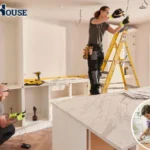Have you ever walked into your home and been greeted by a messy pile of shoes, bags, coats, and miscellaneous clutter? As the entry point of your home, the foyer sets the tone for the rest of your space. An organized foyer looks neat and welcoming, while a disorganized one feels stressful and chaotic.
The solution? DIY foyer benches and storage solutions. Custom-built using simple materials and easy techniques, these practical DIY products are the perfect way to corral the entryway clutter and establish order in your home.
This article will explore the ins and outs of crafting your own foyer organization solutions. You’ll learn the benefits of DIY projects, gather design inspiration, follow step-by-step building guides, and discover clever storage ideas. With a small investment of time and effort, you can create a functional and decorative foyer space your family and guests will appreciate.
I. Introduction
As the transition zone between the outside world and your inner sanctum, the foyer serves an important purpose in home design. This entry space provides a spot to remove muddy shoes, hang up coats, unload bags and boxes, toss keys on a tray, and temporarily stash whatever you’re bringing in or taking out.
With frequent traffic going in and out, bags and shoes accumulating, and outerwear piling up based on the weather, the foyer can quickly become disorganized and cluttered. The resulting mess is an eyesore that makes coming home feel more chaotic than comforting.
DIY foyer benches and storage solutions address these organizational challenges in an affordable and customized way. With simple DIY projects, you can create exactly what you need for your space. The personalized solutions will make your foyer as beautiful and functional as the rest of your well-designed home.
This comprehensive guide will cover all aspects of crafting DIY benches, shelves, hooks, and more specially made for your foyer. You’ll find the inspiration and instructions you need to tackle game-changing foyer organization projects on your own.
II. Understanding the Foyer Space
Before diving into DIY solutions, let’s take a step back to better understand the foyer itself.
What is a Foyer?
The foyer is the entry hall or lobby area leading from the front door into the interior of a home. It serves as a buffer zone and transition space between the outside and inside.
In home design, the foyer sets the stage for what’s to come in the rest of the house. It makes the all-important first impression on anyone entering your home. The foyer also functions as a high-traffic space to sort through belongings coming and going.
Foyer Design Challenges
Though an important space, the foyer presents some unique challenges when it comes to organization and aesthetics.
As the main passageway into the home, it experiences a lot of foot traffic and activity. Family members and guests alike are constantly cycling through to hang up coats, remove shoes, toss down keys, and temporarily set down items carried in and out.
With frequent use and accumulation of belongings, clutter can pile up quickly. Shoes end up strewn about haphazardly. Outerwear overflows its designated spot. There’s no designated place for bags, boxes, or other items passing through.
The nature of the foyer also means flexible storage solutions are needed. Options like a bench for sitting to remove shoes must work year-round, despite bulky winter coats and gear during colder months. Accommodating various users and their different items is key.
Aesthetically, the foyer sets the visual tone for the home. A cluttered or disorganized entryway immediately creates a bad first impression. The chaos disturbs the welcoming atmosphere the foyer should establish.
The Quest for Solutions
These organizational and aesthetic challenges demonstrate the need for functional, clutter-reducing storage solutions tailored specifically to the foyer.
Generic market options often fall short or fail to suit the unique needs of the space. They lack customization options to perfectly fit the available room, coordinate with the home’s style, and accommodate the family’s habits.
The answer lies in DIY projects that provide personalized and purpose-built storage solutions. With custom benches, hooks, cubbies and more, you can outfit your foyer with exactly what you need.
III. Benefits of DIY Foyer Benches and Storage Solutions
DIY storage solutions for the foyer offer many advantages over store-bought options. Building your own custom pieces allows you to reclaim and organize your entryway.
Cost Savings
One of the biggest perks of DIY foyer storage projects is cost savings. Purchasing customized products for your space gets very expensive, very quickly. Simple home-built solutions using standard lumber and basic hardware offer big savings.
You likely already have many of the construction materials on hand, meaning you only have to buy what’s missing. For small projects like benches or shelving, costs often total under $50. Compare that to $200+ for pre-made pieces of the same size!
Personalized Fit
With do-it-yourself solutions, you can take measurements and tailor your projects to perfectly fit your foyer’s size and layout. Store-bought pieces often have limited size options and generic designs ill-suited to your unique space.
You can also customize the storage options to accommodate your family’s needs. Build in the ideal bench shape, shelf height, number of cubbies, and other details that work for you. Market options simply don’t offer that level of purpose-built personalization.
Cohesive Style
DIY projects allow you to match your storage solutions to your home’s decor style for a cohesive and polished look. Opt for finishes, hardware, and even upholstery that coordinate with your color scheme and aesthetic.
Pre-made pieces likely won’t blend seamlessly. But with DIY, you control the materials and finishes to harmonize with the existing design. This level of style customization takes your foyer from disorganized mess to thoughtfully decorated space.
Fun and Fulfilling
Beyond practical perks, DIY solutions offer personal satisfaction. Taking a hands-on approach is enjoyable and rewarding. Building something custom with your own skills improves your foyer while flexing your creative muscles.
The ability to look at a finished, functional piece and say “I made that!” is incredibly fulfilling. DIY projects make upgrading your foyer an entertaining adventure, not just another decor chore.
IV. Design and Planning
Great DIY foyer storage solutions start with careful design and planning. First, assess your space and organizational needs. Then use that information to come up with bench and storage plans tailored to your foyer.
Evaluating Your Foyer
Start by taking measurements of your foyer space. Make note of the traffic flow, doors, existing fixtures, openings, and any problem areas.
Observe how your family uses the space. What items frequently accumulate? Where do shoes end up? What causes clutter? How could storage help?
Think about your interior design style and finishes. What look are you going for? How could custom pieces coordinate and complement your decor?
Consider future needs too. Will usage patterns change as kids grow up? Do you imagine renovating or remodeling anytime soon?
Choosing Pieces and Layouts
With your foyer facts gathered, sketch out ideas for what types of storage solutions make sense.
Foyer benches provide seating to make removing shoes easier. They can also offer shelf or cubby storage underneath. Just be sure to allow adequate floor space around them.
Shelf units are great for stashing bags, gloves, keys and other small items. Place them near the entry door for drop-off convenience.
Coat hooks on the wall or on racks solve outerwear overflow. Just be sure to allow adequate wall space for the number of family members.
Shoe storage cubbies rein in messy piles of footwear. Look for spaces out of main pathways to tuck them.
Table trays neatly corral small items coming and going. Position them near the door for easy access.
Design Tips
When planning your layout:
- Prioritize traffic flow. Don’t block openings or paths.
- Allow room to fully open doors and drawers.
- Make sure spaces are reachable for all family members.
- Incorporate lighting to brighten storage areas.
- Select durable finishes that withstand wear and tear.
- Consider easy-clean options like sealed wood or washable fabric.
V. DIY Bench Construction
The centerpiece of many foyer upgrades is a custom bench. This useful addition provides seating for removing shoes while also offering storage space. With a DIY approach, you can build a bench perfectly sized for your entry.
Materials and Tools
Bench construction uses common materials and tools:
Lumber: 1×4, 1×6, 1×8, or 1×10 boards for the frame. Plywood or boards for the seat top and shelf. Pine or cedar offer affordable options.
Fasteners: Wood screws, pocket screws, brackets, and wood glue. Make sure screws are long enough to secure the thick boards.
Hardware: Hinges, pulls, and shelf pins as needed.
Paint/Stain: Optional if you want a colored bench. Use interior grade for durability. Match your decor.
Cushion: Foam and fabric to upholster the seat for comfort.
Tools: Saw, drill, sanders, carpenter’s square, level, screwdriver, safety gear.
Misc: Wood filler, clamps, painter’s tape.
Cutting Pieces to Size
Start by measuring your space carefully to determine the ideal bench size. Account for traffic flow, doors, and existing pieces.
Cut your lumber pieces to the desired length for the frame legs, supports, and seat rails using a miter or circular saw. Smooth any rough edges with a sander.
Cut the plywood or boards to size for the seat top and lower shelf using a circular saw or handsaw. Add edging if desired.
Joining the Frame
Create the bench frame using wood glue, screws, and pocket holes for simple yet sturdy joinery. Apply glue to joining edges. Clamp pieces together to hold tight as you drive fasteners.
Arrange cross supports near the legs and across the middle to provide stability and support for the seat and shelf. Use pocket holes to easily attach them.
Adding the Seat and Shelf
With the frame complete, attach the plywood or boards for the seat top using glue, clamps, and screws driven from underneath. Position it toward the rear to allow room for the cushion overhang.
Next, install the lower shelf near the base, again using pocket hole joinery. This shelf provides handy storage space. Make sure it doesn’t block leg room.
Applying Finish
Now you can finish the wood bench to match your decor. Paint or stain will protect the DIY bench while complementing your style.
Consider a light shade to keep the small foyer from feeling darker. Neutrals like grays work with most color schemes, while muted blues or greens add subtle personality.
Seal with polyurethane for added durability in your high-traffic area.
Upholstering the Seat
Upholster the bench seat top with foam and fabric for padding and comfort. Use decorator fabric stapled underneath or removable cushion cover for easy updating.
Include a thick foam base layer cut to size. Top it with a Dacron wrap layer and then your show fabric. Keep the cushion slightly narrower than the seat for a cozy overhang.
Installing Hardware
Complete your bench by adding functional hardware. Attaching casters underneath allows you to roll the bench out of the way when needed. Hinges let you hinge up the seat to access hidden storage. Pulls give you easy access to the shelf contents.
Carefully measure and install your hardware straight and securely. Complete any final sanding and touch up paint as needed. Then position your completed bench in your foyer to enjoy!
VI. Storage Solutions
Along with seating, well-designed foyers also incorporate storage solutions for containing clutter. The variety of DIY options available means you can find the perfect custom fit for your space and needs.
Wall Shelving
Open shelving mounted on the wall provides ideal landing spots for bags, gloves, mail, keys, and other small items coming and going each day. Build basic boxy shelving using boards and brackets, or get creative with angled, stepped, or scrolled designs.
Size them to fit your wall space and what you intend to stash there. Place near the entry door for convenience. Finish to match your decor by staining, painting, or using naturally beautiful wood grain.
Cubby Storage
Cubbies make great holding zones in a small entry. Built into a bench base or as standalone units, they allow you to neatly stash shoes, hats, gloves, bags, and other belongings.
Construct cubbies from plywood using basic boxes, dividing shelves, and trim. Or frame them using slats, lattice, shiplap or other materials that coordinate with your style. Paint, stain, or decoupage the surfaces for added flair.
Coat and Towel Hooks
Hooks mounted near your foyer entrance provide a quick spot to hang coats, bags, leashes, towels, and more. Group hooks on a board, install individual hooks on the wall, or incorporate hanging rods or rails for larger storage capacity.
Opt for durable hooks rated for heavy items. Spread them at least 8-10 inches apart for functionality. Consider finishes like black, brass, or nickel that complement your decor.
Table Trays and Baskets
Treating your foyer like a mini-mudroom also brings in handy catch-all storage options. Trays, baskets, bins, and dishes stationed near the door let you quickly drop keys, sunglasses, mail, and other small belongings coming and going.
Try woven baskets for rustic charm or sleek metal dishes and trays for contemporary style. Labeling them helps distinguish each person’s landing zone. These portable pieces are easy to arrange and rearrange.
VII. Incorporating Organization and Functionality
With your DIY benches, shelves, and storage solutions built, it’s time to incorporate them into your foyer in a functional way. Use these tips to maximize organization and minimize clutter.
Edit Before Adding Storage
Before building storage solutions, go through an edit. Remove unused items and seasonal gear not needed now. This prevents filling your new spots with unnecessary clutter.
Map Out Traffic Flow
Pay attention to high-traffic pathways when mapping out bench and storage locations in your layout. Avoid blocking openings or creating bottlenecks.
Allow Ample Access Space
When positioning benches, coat hooks and other items, make sure to leave adequate space around them. There should be room to fully open doors and drawers without blocking access.
Zone by User
If multiple family members share the foyer, zone storage areas by person or usage. Give each coat hook section, cubby, tray, etc. Designate zones with labels, colors or borders.
Store Items Close to Their Use
Place items near where they are used for convenient access. For example, locate coat hooks immediately inside the entry door so outerwear can easily be grabbed or hung up coming or going.
Incorporate Lighting
Good lighting is key for a functional foyer. Illuminate storage areas and benches to eliminate dark corners and spot items easily. Hooks, cubbies, and shelves all benefit from targeted fixture placement.
Maintain Visible Storage
Open organization is ideal for quick grab-and-go storage. Baskets, trays, and open hooks prevent “out of sight, out of mind” clutter pile-ups. Closed cabinets easily become jumbled junk drawers.
Purge and Reset Regularly
Do occasional purge-and-reset checks. Remove unneeded items, reorganize to maximize space, and return items to their designated zones. This prevents disorganization creep.
VIII. Aesthetics and Finishing Touches
In additional to being functional, well-designed DIY foyer storage also has visual appeal. Use these tips to finish your pieces with aesthetics and cohesiveness in mind.
Align with Your Decor Style
Choose finishes and hardware that coordinate with your home’s overall decor style. For example, visible wood grain suits Craftsman interiors, while painted pieces work for Farmhouse. Pulls and knobs should complement your style too.
Tie-In Finishes
Use like finishes to tie DIY storage pieces together visually. For instance, if your bench and shelves share the same stain, paint color, or hardware, they will look cohesive and purposeful.
Mind the Details
It’s all in the details! Well-made DIY projects include finishing touches like sanded edges, trimmed corners, proper joins, and durable surfaces. Take time with these aspects for a polished look.
Add Interest With Upholstery
Upholster your bench top with attractive fabric that adds softness, texture, and color to your foyer. Integrate piping or nailheads to complement your style. Use patterns and textures sparingly.
Incorporate Greenery
Bring life to your foyer storage solutions by incorporating living plants. Succulents or air plants on shelves, a snake plant next to a bench, or a potted fern in a corner help liven up the space.
Layer in Decor Items
Artful displays layered on and around DIY storage add visual interest. Try framed photos, decorative bowls, stacked books, candlesticks, and similar decorative accents in small doses.
IX. Maintenance and Longevity
To help your DIY foyer benches, cubbies, and shelves look great for years, be diligent about simple maintenance. Protect your investment of time, money and effort.
Use Durable Materials
Select quality woods, sturdy hardware, and weather-resistant finishes when constructing DIY projects. Pine, cedar, and exterior-grade plywood hold up well. Opt for brushed nickel over brass finishes.
Seal and Protect Surfaces
Sealing wood surfaces with polyurethane and painting where possible helps DIY projects withstand bumps and wear and tear. Touch up annually. Replace fabric as needed.
Check Hardware and Joints
Periodically check for loose screws, hardware, and joints. Tighten or reinforce as needed to maintain structural integrity. Don’t wait for things to become loose or saggy.
Clean Surfaces Gently
Use soft cloths and mild cleaners on wood, hardware and upholstery. Avoid excessive water and harsh chemicals. Persistent scuffs can be gently sanded and touched up.
Repair Damage Promptly
Address any issues like warped boards, peeling finishes, or broken hardware right away to prevent bigger problems. Your vigilance will keep DIY projects looking their best.
Consider Refreshing Finishes
Plan on refreshing painted or stained finishes every 2-3 years to keep things looking crisp. Take cushions and fabric covers off annually for cleaning.
Reassess Functionality
As family needs change, reevaluate if your storage setup still works or needs adjustments. Expand, reconfigure, or remove pieces as required. DIY projects make this easy.
With proper care and maintenance, your DIY foyer storage solutions can serve your family beautifully for over a decade. The small amount of upkeep is well worth the ongoing clutter relief.
X. Real-Life Examples and Success Stories
If these descriptions and tips seem theoretical, seeing real DIY foyer storage projects in action helps make it tangible. Read on for examples and success stories from real households.
Rustic Foyer Bench
Amanda C. built a rustic X-frame bench for her cozy cabin foyer using cedar boards. With a weathered gray finish, natural jute cushion, and antique cast iron pulls, it fits the surroundings perfectly. Underneath, built-in cubbies lined with chicken wire neatly store shoes and other items. Amanda loves having seating to take on and off boots by the door along with hidden storage.
Modern Console Bench
James S. created a sleek, contemporary bench for his family’s city apartment foyer. With tapered wooden legs in a light finish, marble-print vinyl seat upholstery, and brass hardware, the DIY bench elevates the small space. It provides a designated spot for piling mail, bags, and other items when coming and going. James was able to customize the bench dimensions to fit the foyer opening precisely.
Rustic Wall Storage Rack
Jenn G. hand-built an asymmetrical wall storage rack from pine boards, copper pipes, and hemp rope. Mounted next to the front door of her eclectic cottage, this piece corrals scarves, pet leashes, reusable bags, and other items her family takes on the go. The unique DIY rack cost under $30 in materials and adds beautiful functional decor. “It’s become the heart of our home’s organization,” says Jenn.
Gardener’s Foyer
An avid gardener, Sue K. turned her unused foyer niche into a gardening station. She installed potting table-height shelving and hooks for supplies and gear. Gardening baskets underneath store gloves, tools and knee pads right by the door for easy access heading outside to garden. The green space brings life to the previously ignored foyer area while keeping frequented items accessible yet out of sight.
Kid-Friendly Entryway
When Lisa P. needed to corral her kids’ school and sports gear flooding her home’s entryway, she came up with a fun DIY solution. She built a bench with cubbies for shoes beneath and an oversized chalkboard above. The kids now have dedicated spots to store their things creatively color-coded on the chalkboard. “It’s transformed our chaotic entryway into an organized system,” raves Lisa.
XI. Conclusion
As you can see, DIY storage solutions offer an affordable and customized approach to taming disorder in your foyer. With benches, shelving, hooks and cubbies purpose-built for your space, you can establish organization in your home’s entry point.
Beyond just containing clutter in your active entrance area, DIY projects allow you to match your family’s needs while complementing your decor. Small investments of time and money yield functional, decorative pieces crafted specially for your home.
Don’t tolerate a disorganized mess each time you walk through your front door. Follow this guide to create custom foyer storage solutions through simple DIY projects. Just think – soon your beautifully organized entryway can offer a warm welcome to all who enter your home!




